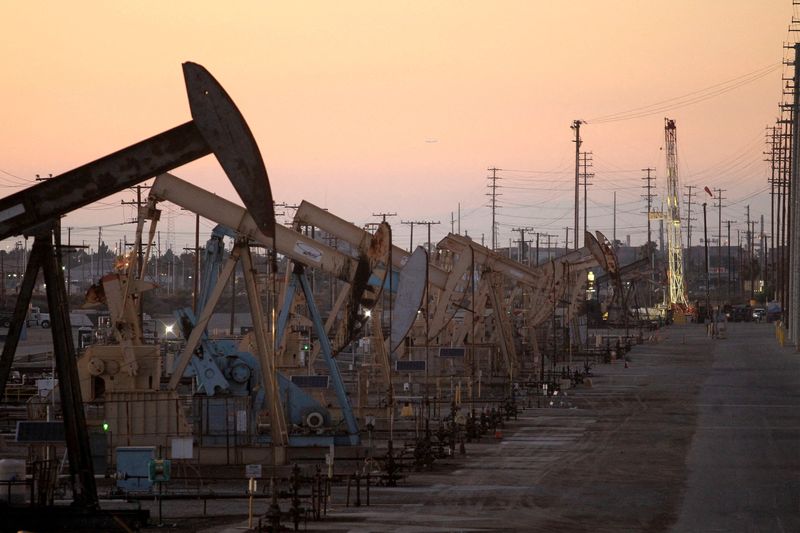Commodities
Oil prices steady as investors weigh up Gaza ceasefire signals


© Reuters. FILE PHOTO: Oil rig pumpjacks, also known as thirsty birds, extract crude from the Wilmington Field oil deposits area near Long Beach, California July 30, 2013. REUTERS/David McNew//File Photo
By Paul Carsten
LONDON (Reuters) -Oil prices held relatively steady on Tuesday, wavering only a few-dozen cents up or down, as traders kept their powder dry on the outcome of Gaza ceasefire talks, U.S. inflation data on Thursday and whether OPEC+ will extend voluntary cuts in March.
futures fell 28 cents, or 0.34%, to $82.25 a barrel by 1251 GMT. U.S. West Texas Intermediate crude futures (WTI) were down 21 cents, 0.27%, to $77.37 a barrel.
Mixed signals came from the Middle East as U.S. President Joe Biden said Israel is ready to halt its Gaza attacks for the Muslim holy month of Ramadan in a ceasefire that could be signed as soon as next week. But Hamas officials said Biden’s remarks were premature as it studies a truce offer.
Also potentially countering the oil price impact of Biden’s comments, Yemen’s Houthi spokesperson on Tuesday said the group’s operations in the Red Sea, waged in support of Palestinians in Gaza, will only stop when Israeli “aggression” on Gaza ends and the siege is lifted.
Houthi missiles and drones have been threatening international shipping, driving up the cost of transporting energy products and contributing to a tighter market.
“Concerns around shipping disruptions in the Red Sea have supported a rebound in the price of crude oil overnight,” said Tony Sycamore, an analyst at IG in Sydney.
Both oil benchmarks had settled more than 1% higher on Monday, after declines of 2-3% over the previous week as markets factored in a greater likelihood that rate cuts might take longer to come.
Kansas City Federal Reserve Bank President Jeffrey Schmid on Monday signalled that he, like most of his central banking colleagues, is in no rush to cut interest rates. High borrowing costs typically reduce economic growth and oil demand.
The January U.S. personal consumption expenditures price index, the Fed’s preferred measure of inflation and a key factor in rate decisions, is due on Thursday.
Elsewhere, eyes are on the OPEC+ producer group, with a decision coming in March on whether to extend voluntary production cuts to bolster prices.
“We expect OPEC+ to announce the rollover of voluntary production quotas, at least until the June Ministerial Meeting to provide additional support,” said Helima Croft of RBC Capital Markets in a note late on Monday.
Tuesday’s wariness from investors – many of whom are in London attending International Energy Week, one of the industry’s biggest annual get-togethers – comes despite a range of news supportive of higher oil prices, like an expected OPEC+ extension.
“Concerns over Chinese demand are abating, as refineries continue brisk buying in the physical market after a boom in Lunar New Year travel,” analysts from ANZ Bank said in a note.
Also on Tuesday, Russian authorities announced a six-month ban on gasoline exports from March 1 to compensate for rising demand and to allow for refinery maintenance.
Later on Tuesday, the American Petroleum Institute industry group’s weekly inventories data is due to be released, at 4:30 p.m. EST (2130 GMT).
Commodities
Oil prices rise; U.S. crude inventories plunge, Russia-Ukraine truce eyed
Commodities
India’s Reliance to stop buying Venezuelan oil over US tariffs, sources say
Commodities
Oil prices climb on Venezuela supply worries

 Forex3 years ago
Forex3 years agoForex Today: the dollar is gaining strength amid gloomy sentiment at the start of the Fed’s week

 Forex3 years ago
Forex3 years agoUnbiased review of Pocket Option broker

 Forex3 years ago
Forex3 years agoDollar to pound sterling exchange rate today: Pound plummeted to its lowest since 1985

 Forex3 years ago
Forex3 years agoHow is the Australian dollar doing today?

 Cryptocurrency3 years ago
Cryptocurrency3 years agoWhat happened in the crypto market – current events today

 World3 years ago
World3 years agoWhy are modern video games an art form?

 Commodities3 years ago
Commodities3 years agoCopper continues to fall in price on expectations of lower demand in China

 Economy3 years ago
Economy3 years agoCrude oil tankers double in price due to EU anti-Russian sanctions



























